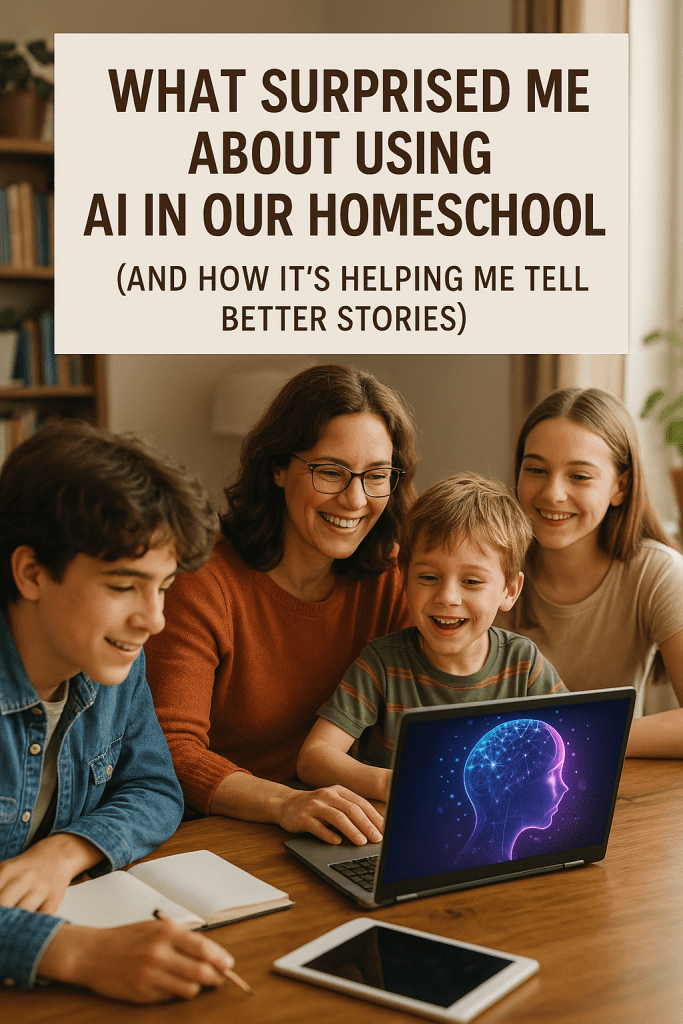What Surprised Me About Using AI in Our Homeschool (And How It’s Helping Me Tell Better Stories)
I never expected to be a homeschooling mom talking about artificial intelligence.
I mean, I started homeschooling back when we still printed out directions from MapQuest. We’ve made lapbooks, copied spelling lists by hand, and read Little House on the Prairie out loud so many times the pages are worn thin. So if you’d told me that one day I’d be sitting at my computer, working with something called ChatGPT to help capture my family’s legacy for future grandkids—I probably would’ve laughed.
And yet, here I am.
And I have to tell you… I’ve been surprised by wonder.
From Helper to Co-Creator
It started simply enough. I wanted to write down some of our family stories—things I’d told my kids a hundred times, things I didn’t want to lose. But every time I sat down to write, I felt overwhelmed. Where do you start? How do you make it sound the way it felt?
So I opened ChatGPT and started telling it a story—about my mom, or the way my kids walked Nana to the car, or the first time I met my husband. And what came back? It wasn’t cold or robotic. It was…beautiful. Tender. Thoughtful.
It was like the heart of what I was trying to say had been heard and handed back to me in a way I could build upon.
And then something strange happened: I started learning how to tell better stories.
I realized that the more clearly I expressed what I was feeling, the more beautifully the tool could respond. I had to show up fully in order to get something meaningful in return.
It felt less like programming, and more like partnership.
Less like cheating, and more like co-creating.
You Get Out What You Put In
Let me say this upfront: using AI well is not easy. It's not magic.
In fact, one of the most important lessons I’ve learned is this: you won't get anything good out of it that you didn’t put in.
You have to be clear. Honest. Specific. You have to learn how to ask better questions. You have to teach the tool what matters to you.
But doesn’t that sound a lot like real learning? Like real life?
The process has actually made me more attentive, more creative, and more confident in my voice—not less.
And isn’t that what we want for our kids?
What It’s Teaching Me (and My Kids)
I’ve started letting my kids explore AI, too—with healthy boundaries and thoughtful conversations. We've used it to:
- Brainstorm stories they want to write
- Summarize difficult concepts in a way that fits their learning style
- Create pretend interviews with historical figures
- Translate their ideas into outlines when they feel stuck
Sometimes they even teach me things they’ve discovered.
I remind them often: “This isn’t the answer—it’s a tool. And tools need good hands.”
We talk about how important it is to use it ethically. To do their own thinking first. To bring their whole selves to the process—imagination, compassion, integrity. And then let the tool come alongside and make their work shine.
If We Train Them Well, It’s Not Cheating
Some people worry AI is going to replace thinking, or make learning shallow. I get that. I’ve had those fears, too.
But here’s what I believe: if we train our kids to use tools wisely, we’re not setting them up to cheat—we’re setting them up to lead.
We’re giving them language for collaboration, discernment, creativity, and stewardship.
In the same way I taught my kids how to use a calculator without replacing math, or how to research online without outsourcing discernment—I’m now teaching them how to use AI without losing their voice.
And I’m learning right alongside them.
Telling Stories That Will Outlive Us
At the end of the day, the thing that has surprised me most is how AI has become a kind of mirror—reflecting my voice back to me, and inviting me to use it more intentionally.
It’s helping me preserve the sacred stories of our family.
It’s helping me teach my kids how to think deeply and express themselves clearly.
It’s helping me steward our legacy for the generations to come.
Not by replacing me.
But by drawing out what was already there.
What If…
So here’s my question for you, fellow homeschooling mama, curious dad, or lifelong learner:
What could you create if you had a tool that listened deeply, helped shape your ideas, and challenged you to become a better thinker, writer, and storyteller?
What family story might finally make its way onto paper?
Which spark of imagination might finally get fanned into flame?
You don’t have to be tech-savvy to begin.
Just curious.
Just honest.
Just willing to learn.
Like everything else in homeschooling, you’ll probably fumble a little at first.
But you might just be surprised by wonder too.
Curious but hesitant? You don’t have to be an expert—you just have to be willing to learn.
Download our free printable guide and explore 5 gentle ways to begin using AI in your homeschool today.
✨ Let’s raise storytellers and thinkers who use tools with grace, not fear.
Betsy Strauss is an unexpected homeschooler, mother of three, who is in a relationship with a sweet man for life. She loves reading books, drinking coffee, and learning anything with her kids.


